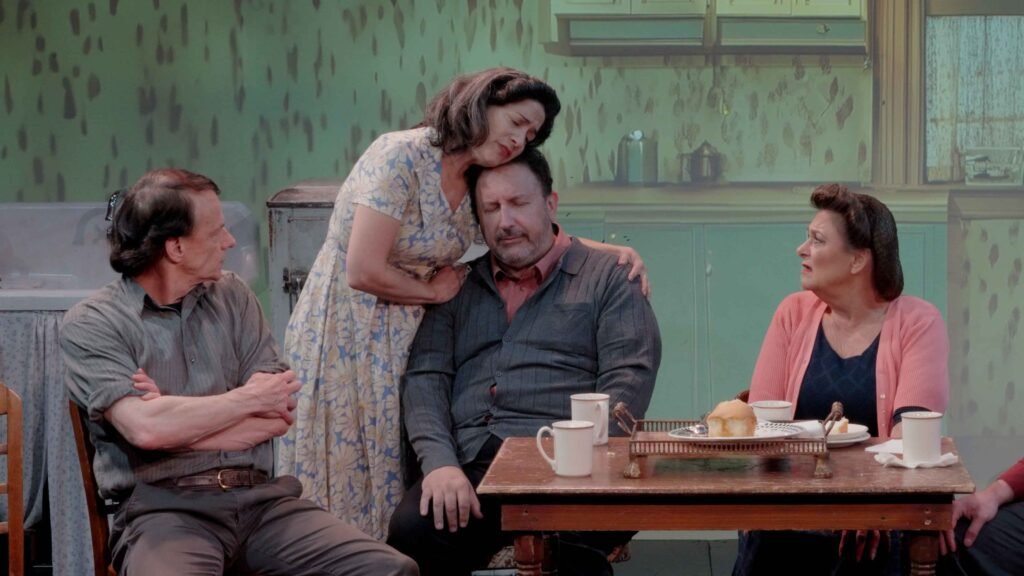The Play’s Performance History
Grief: A Love Story was performed three times on September 22, 23, and 24, 2024, under the aegis of the Philadelphia Fringe Festival, 2024. Three hundred people attended these performances.

I. One-Sentence Summary
In 1952, in New York City, a tragic yet humor-laced story unfolds as Holocaust survivors and American Jews confront their divide, grappling with issues of God and forgiveness in a post-Holocaust world.
II. Emotional Hook
The play combines grief, healing, and human connection. Its characters navigate their trauma while finding moments of hope, humor, and reconciliation. Audience members found it both wrenching and uplifting. One reviewer wrote, “There is a somatic palpability to this play. This reminds me of the Greek notion of catharsis, which is that one emerges from this play changed by the experience of witnessing it.”
III. Synopsis
In 1951, in a Jewish neighborhood in New York City, Jacob and Eva, Holocaust survivors, struggle to adjust to life in America. Eva pushes Jacob to improve their situation by attending TV repair school, even pawning her mother’s ring to pay for it. Still, Jacob remains stuck, haunted by guilt over not saving his family from the Nazis. After a brief affair with another refugee, Rachel, Jacob feels a glimmer of hope. Meanwhile, their American-born neighbors, Abe and Bertha, face their struggles—childlessness has driven a wedge between them, with Abe finding solace in tutoring Jacob’s son Harold, a young math prodigy. At the same time, Bertha turns to controlling her body and slipping into anorexia. Both couples confront deep emotional wounds, and their lives intersect at critical moments, especially under the guidance of a well-meaning but emotionally disconnected Rabbi.
The turning point comes when Eva learns of Jacob’s affair, which leads to Harold’s tragic accidental death. Jacob organizes a shiva with the Rabbi, but Eva, overwhelmed with anger at God, abruptly ends it on the first day. In an unexpected encounter on the street, Eva confronts Rachel, and in a tense, emotional exchange, the two women find reconciliation through their shared grief and Rachel’s insight. Feeling partially responsible for Harold’s death, Abe holds his own unconventional shiva, bringing all the characters together in their collective mourning. Despite the Rabbi’s emotional distance, he provides a moment of catharsis through a Yom Kippur prayer and a Kaddish, helping Eva release her pent-up sorrow. The play concludes with tentative reconciliation, as love and faith begin to ease the characters’ burdens. In a final flashback, Jacob recalls his escape from the ghetto, where a friend’s words—that both Jacob and his parents did their best—offer him the hope of eventual forgiveness for both him and his lost loved ones.
IV. Tone and Genre
The play is a tragedy told through realistic storytelling. The play, wrenching and uplifting, is laced with humor. The throughline of the plot, based on Jacob’s affair and Eva’s hocking her ring to pay for Jacob’s schooling, drives the story forward and the characters’ decisions. The first half of the play interweaves character development with considerable humor; in one scene, a group of survivors tell off-color jokes even as they test each other on matters of faith and commitment. Jacob’s brief affair triggers Harold’s death in the second half of the play. At first, grief and anger shape the character’s dialogue, but as the story draws closer, the characters express forgiveness and love.
V. The Play's Themes
1. Survivor’s Guilt and Trauma
Jacob’s struggle with guilt over not doing enough to save his family during the Holocaust highlights the deep emotional scars that survivors carry. This theme explores the long-lasting psychological impact of trauma and the complexity of forgiveness—both of oneself and of others.
2. Faith and Doubt
The play examines how faith is challenged by tragedy. Jacob’s need to work on Shabbos, Abe’s rejection of prayer in favor of mathematics, and Eva’s anger at God reflect a central tension: the fragility of faith in the face of overwhelming suffering. The characters wrestle with maintaining religious traditions and beliefs amid personal and historical devastation.
3. Grief and Reconciliation
Grief is a driving force throughout the play. The characters deal with different forms of loss: Eva and Jacob lose their son Harold, Abe and Bertha struggle with infertility, and the shadow of the Holocaust hangs over everyone. The reconciliation between characters, such as Eva and Rachel, suggests that while grief is overwhelming, love and understanding can provide healing.
4. The Struggle to Assimilate
Jacob and Eva’s adjustment to life in America as Holocaust survivors—navigating between their past traumas, Orthodox Jewish traditions, and the American dream—illustrates the challenges of assimilation. Their tension between religious obligations and financial survival (working on Shabbos, for example) highlights how displacement and cultural differences complicate identity.
5. The Role of Community and Tradition
The synagogue and its Rabbi serve as central pillars of the Jewish community, attempting to uphold traditions while addressing the needs of displaced people. The Rabbi’s limitations—his inability to emotionally connect—represent the sometimes imperfect role of religious leaders in holding together a fractured community.
6. Forgiveness and Redemption
By the end of the play, both personal and communal forgiveness are crucial. Jacob’s flashback suggests that even though he carries the burden of guilt, forgiveness is possible—not only from his loved ones but also from himself. The Rabbi’s invocation of Yom Kippur prayers helps the characters seek redemption and relief from their guilt.
7. The Complexity of Love and Relationships
Love is portrayed as multifaceted, bringing both conflict and healing. Jacob’s affair with Rachel, Eva’s resentment, and Abe’s emotional investment in Harold all represent different expressions of love and attachment. By the end, relationships begin to mend, and love emerges as a source of resilience in the face of profound grief.
These themes collectively explore the intersection of personal trauma, religious identity, and the search for healing in a post-Holocaust world.